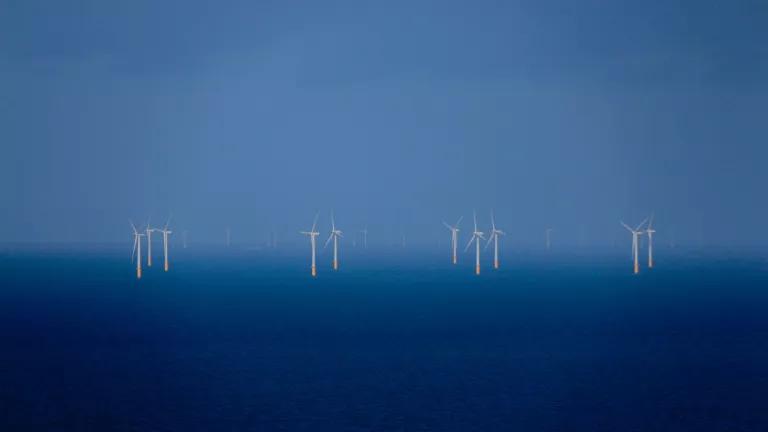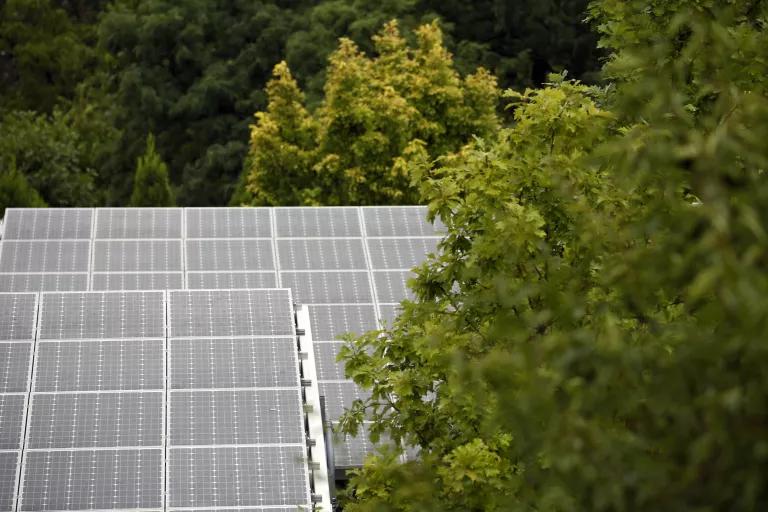IEA: Renewable Energy Has Winning Potential
The International Energy Agency says solar is about to boom (some more) and offshore wind farms could power the whole world—18 times over! If we let them, that is.

Offshore wind farms are capable of providing more electricity than the world needs.
The International Energy Agency (IEA) is precisely what its name suggests: an intergovernmental consortium that monitors energy markets around the world and works to keep global energy supplies stable. The Paris-based agency’s establishment was a response to the 1973 oil crisis, but in recent years the IEA has brought renewable energy into its analytical ambit as the world market for renewables has taken off.
Even so, many have criticized the IEA for downplaying or even outright dismissing the potential of renewables while simultaneously overstating or even outright inflating the continued potential of fossil fuels. The IEA, in other words, is by no means in the tank for wind and solar, even if it feels compelled to report and comment on the enormous progress that renewables have made over the past decade.
Which is why a pair of reports the IEA released back-to-back last week are so significant. Both reports extol renewable energy sources in language that could accurately be described as semi-rhapsodic. (The sober-minded analysts at the IEA don’t really do full-on rhapsody.) And while some of the agency’s findings should be taken with a grain of fleur de sel, the reports are notable for their unprecedentedly optimistic tone regarding a sector to which the IEA has tended to give short shrift in the past. Taken together, they should help put to rest any questions as to whether wind and solar have the potential to power the United States—or even the entire world—should we have the wisdom to keep investing in them.

The first report, bearing the oh-so-provocative title “Renewables 2019,” is a snapshot of the renewables sector as it stands right now, but it leads with an eye-popping prediction: Renewable power capacity will expand by 50 percent between 2019 and 2024. This is an increase of 1,200 gigawatts, “equivalent to the total installed power capacity of the United States today.” Fully 60 percent of this explosive growth is predicted to be in the solar category, driven by deep drops in price that would attract businesses and factories eager to cut costs and homeowners eager to generate their own on-site electricity. China will likely lead the global pack in solar expansion, accounting for nearly half of it, and also take the first-place ribbon in renewables expansion overall, accounting for 40 percent.
It’s stunning enough to learn that renewable energy is poised to grow over the next five years by an amount equal to our nation’s current installed power capacity. (Power capacity, in case you’re wondering, is generally defined as the maximum output of electricity that a generator is capable of producing under ideal conditions.) But there’s an even more stunning observation to be found in the second IEA report, the audaciously titled “Offshore Wind Outlook 2019.” According to the agency, offshore wind energy, using “high-quality resources available in most major markets,” has the potential to generate more than 18 times the current electricity demand of the entire world.

Yes, you read that correctly. Global electricity demand is most often measured in terawatt-hours (TWh), each unit of which is equivalent to one trillion watts of electrical energy consumed over the course of one hour. Right now, the global demand for electricity is about 23,000 TWh. But were we to invest sufficient time, money, and political willpower toward the goal of letting offshore wind live up to its full potential, this clean and renewable energy source, all on its own, could generate more than 420,000 TWh worldwide. And while we may not be able to achieve this dreamlike goal in the near term, the IEA nevertheless projects that global offshore wind capacity will grow to 15 times its current size by 2040, becoming a $1 trillion industry in the process. In this case, China will probably have to settle for second place behind the European Union, which is projected to expand its offshore wind capacity from 20 gigawatts today to 130 gigawatts by 2040.
So, where does that leave the United States? Our offshore wind industry is just getting started, and while wind and solar together generate just as much electricity as coal in this country (in fact, a smidge more), we could do a lot better when it comes to investing in the energy sources of the future.

Just a few days after the IEA reports came another telling energy forecast. On Tuesday it was revealed that coal giant Murray Energy had filed for Chapter 11 bankruptcy protection in federal court, making it the eighth coal company to do so over the past year. Weakened by the steady emergence of ever-more-affordable renewables and natural gas, the largest private coal company in America was ultimately unable to pay its creditors. The fall of this onetime energy titan is just the latest example of “how market forces have sealed the fate of coal,” as Environmental Working Group president Ken Cook told the New York Times.
The IEA reports bode well for the ongoing fight against climate change, but the agency’s use of the word potential is important to emphasize. Their forecasts are meant to show us what we could do, not predict what we will do, with the bounteous gifts of wind and solar that we’re just beginning to unpack and appreciate. But we won’t realize the benefits of all this clean-energy potential until we develop and implement the infrastructure required to deploy them. “Renewables are already the world’s second-largest source of electricity,” says IEA executive director Fatih Birol, “but their deployment still needs to accelerate if we are to achieve long-term climate, air quality, and energy access goals.”
Meaning: It’s up to us to make it happen. The potential is there. The technology exists. And the stakes have been made starkly clear. But until we commit ourselves wholly to the task of investing in—and scaling up—the means to turn abundant wind and sunlight into electricity, all the IEA’s exciting scenarios will remain just that: exciting scenarios.
This article was originally published on onEarth, which is no longer in publication. onEarth was founded in 1979 as the Amicus Journal, an independent magazine of thought and opinion on the environment. All opinions expressed are those of the authors and do not necessarily reflect the policies or positions of NRDC. This article is available for online republication by news media outlets or nonprofits under these conditions: The writer(s) must be credited with a byline; you must note prominently that the article was originally published by NRDC.org and link to the original; the article cannot be edited (beyond simple things such grammar); you can’t resell the article in any form or grant republishing rights to other outlets; you can’t republish our material wholesale or automatically—you need to select articles individually; you can’t republish the photos or graphics on our site without specific permission; you should drop us a note to let us know when you’ve used one of our articles.

What’s the Most Energy-Efficient Water Heater?
A Consumer Guide to the Inflation Reduction Act
Can Hydrogen Help Combat the Climate Crisis?
What’s the Most Energy-Efficient Water Heater?
A Consumer Guide to the Inflation Reduction Act
Can Hydrogen Help Combat the Climate Crisis?
What’s the Most Energy-Efficient Water Heater?
A Consumer Guide to the Inflation Reduction Act
Can Hydrogen Help Combat the Climate Crisis?
What’s the Most Energy-Efficient Water Heater?
A Consumer Guide to the Inflation Reduction Act